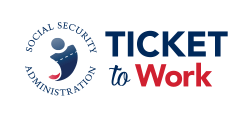History of the Ticket to Work Program
The Ticket to Work and Work Incentives Improvement Act of 1999 (P.L. 106-170) was signed into law to increase the options for individuals with disabilities who wished to return to work.
The Social Security Administration pays disability benefits under two national programs authorized in the Social Security Act: Social Security Disability Insurance (SSDI - Title II) and Supplemental Security Income (SSI - Title XVI). Individuals receiving both SSDI and SSI benefits are called concurrent beneficiaries.
The SSDI program provides cash benefits to individuals who are disabled or blind and are "insured" by workers' contributions to the Social Security Trust Fund. These contributions are based on a worker's earnings (or those of the worker's spouse or parents). The SSI program provides cash assistance to individuals who are elderly, blind, and/or disabled who have limited income and resources. Funding for SSDI comes from the Social Security Trust Fund; funding for SSI comes from Federal tax revenues.
In the 1990s, a number of people, including the Committee on Ways and Means in the U.S. House of Representatives, expressed concern that only half of 1 percent of Social Security disability beneficiaries were leaving the disability rolls due to work and earnings. People also expressed concern that beneficiaries interested in pursuing work only had one option, namely to seek assistance from a State Vocational Rehabilitation (VR) agency. These concerns, coupled with the interest many community-based service providers had in getting involved in assisting beneficiaries with their return-to-work efforts resulted in new support for expanding the options available to beneficiaries for obtaining employment services and supports.
The resulting Ticket to Work and Work Incentives Improvement Act of 1999 (P.L. 106-170) includes:
- Two programs to address the fear many Social Security disability beneficiaries have of losing critical health care coverage. The "Continuation of Medicare Coverage" extended premium-free Part A Medicare coverage for a total of 93 consecutive months for SSDI beneficiaries who work. A State Medicaid buy-in option allowed some states to increase their flexibility for covering workers with disabilities. Contact your State Medical Assistance Office to see if your state has a Medicaid buy-in. Call 1.800.MEDICARE or 1.877.486.2048 (TTY) to get the number for your state office.
- Enhancements to existing work incentive programs. Work incentives are special Social Security rules that make it easier for beneficiaries with disabilities to work and still receive health care and disability benefits from Social Security while initially exploring work. The Ticket to Work Program (Ticket Program) is one example of a Social Security work incentives program. Learn more about work incentives in the Social Security Red Book.
- Authority to fund community-based organizations to provide work incentives planning assistance to Social Security disability beneficiaries (Work Incentives Planning and Assistance or WIPA projects). WIPA projects employ certified benefits planners (Community Work Incentive Coordinators or CWICs) to help beneficiaries understand and use available work incentives, including the Ticket Program. Locate the WIPA serving your state.
- Authority to fund advocacy services and legal representation for beneficiaries with disabilities (Protection and Advocacy for Beneficiaries of Social Security or PABSS). Locate the PABSS serving your state.
- Authority to pilot a $2 for $1 benefit offset demonstration project for individuals receiving SSDI benefits, i.e., the Benefit Offset National Demonstration (BOND) project.

